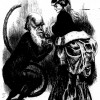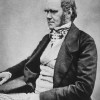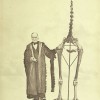
Jonathan Smith, “The Huxley-Wilberforce ‘Debate’ on Evolution, 30 June 1860”
The “debate” over evolution between T. H. Huxley and Bishop Samuel Wilberforce at the 1860 meeting of the British Association for the Advancement of Science in Oxford is an iconic story in the history of evolution and, indeed, in the history of the conflict between science and religion, second only to Galileo’s troubles with the Vatican. Huxley, the traditional account has it, vanquished Wilberforce by responding to an insulting question about his own ancestry with a masterful rejoinder that exposed the Bishop’s ignorance of science and ungentlemanly behavior. Historians have shown that this traditional account is biased and distorted, a construction many years after the fact by the Darwinians and their allies, yet it continues to live on, even in literary studies. Reconstructing the Huxley-Wilberforce encounter, the contexts in which it took place and what is and is not known about it, yields an understanding of the relationship between religion and science in the Victorian period that is fuller and more complex than the traditional “conflict” model.

Cannon Schmitt, “On the Publication of Charles Darwin’s On the Origin of Species, 1859″
The publication of Charles Darwin’s On the Origin of Species (1859) often serves as shorthand for the first appearance of evolutionary theory. But Darwin wrote at a time when several different theories of evolution had already been proposed. Moreover, his own version of evolution had been known to select colleagues well before 1859 and became available to a wider public in 1858. Appreciating the nature of Darwin’s contribution and the extent of his success requires understanding this contemporary context as well as something of the subsequent fate of the Origin’s key idea: natural selection.

Gowan Dawson, “On Richard Owen’s Discovery, in 1839, of the Extinct New Zealand Moa from Just a Single Bone”
In 1839 Richard Owen inferred the existence of a hitherto unknown giant flightless bird in New Zealand from the evidence of just a small fragment of femur bone. This prediction was spectacularly confirmed three years later with the arrival of a consignment of bones from which Owen was able to reconstruct the entire skeleton of the wingless Moa or, as he named it, Dinornis. This essay explores the scientific and religious implications of Owen’s famous feat of inductive reconstruction, and also examines how it was represented in the Victorian print media.
